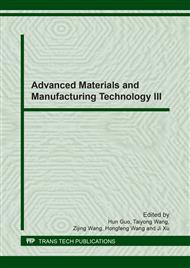[1]
X. L. ZHANG, B. YAO, W. FENG, et al. Modelling of virtual grinding wheel based on random distribution of multi abrasive grains and prediction of grinding force, Acta Aeronautica et Astronautica Sinica. 12 (2014) 3489-3498.
Google Scholar
[2]
Matsuo T, Toyoura S, Oshima E, et al. Effect of grain shape on cutting force in super abrasive single-grit tests, CIRP Annals-Manufacturing Technology. 1(1989)323-326.
DOI: 10.1016/s0007-8506(07)62714-0
Google Scholar
[3]
Yoshioka M. Waveform of grinding force for single grain grinding-grinding of a brittle material by a single abrasive grain (2nd report), Journal of Japan Society of Precision Engineering. 03(1993)515-520.
DOI: 10.1016/0141-6359(93)90210-2
Google Scholar
[4]
Desa O, Bahadur S. Material removal and subsurface damage studies in dry and lubricated single-point scratch tests on alumina and silicon nitride, Wear. 225-229(1999)1264-1275.
DOI: 10.1016/s0043-1648(99)00048-4
Google Scholar
[5]
L. YAN, F. JIANG, Y. M. RONG. Grinding mechanism based on single grain cutting simulation. Journal of Mechanical Engineering. 11(2012)172-182.
DOI: 10.3901/jme.2012.11.172
Google Scholar
[6]
Ramesh K, Yeo S H, Gowri S, et al. Experimental evaluation of super high-speed grinding of advanced ceramics, International Journal of Advanced Manufacturing Technology. 2(2001)87-92.
DOI: 10.1007/s001700170196
Google Scholar
[7]
Y. C. FU, L. TIAN, J. H. XU, et al. Development and application on the grinding process modeling and simulation, Journal of Mechanical Engineering. 7(2015)197-205.
Google Scholar
[8]
Jackson M J, Davis C J, Hitchiner M P, et al. High-speed grinding with CBN grinding Wheels-applications and future technology, Journal of Materials Processing Technology. 1(2001)78-88.
DOI: 10.1016/s0924-0136(00)00869-4
Google Scholar
[9]
C. SU, L. XU, Y. W. LIU, et al. Numerical simulation of cutting process of CBN grit based on SPH method, China Mechanical Engineering. 5(2013)667-671.
Google Scholar
[10]
Y. LAN, X. K. LI, WALEED B R, et al. Research on microscopic grain workpiece interaction in grinding through micro-cutting simulation, Advanced Materials Research. 76(2009)9-14.
DOI: 10.4028/www.scientific.net/amr.76-78.9
Google Scholar
[11]
KOMANDURI R, CHANDRASEKARAN N, RAFF L M. MD simulation of indentation and scratching of single crystal aluminum, Wear. 240(2000)113-143.
DOI: 10.1016/s0043-1648(00)00358-6
Google Scholar
[12]
SHIMIZU J, ZHOU L B, EDA H. Simulation and experimental analysis of super high-speed grinding of ductile material, Journal of Materials Processing Technology. 129(2002)19-24.
DOI: 10.1016/s0924-0136(02)00568-x
Google Scholar
[13]
RENTSCH R, BRINKSMEIER E. Teratology aspects in state of the art MD cutting simulations, Chemnitz in Germany, 8th. CIRP Int. Workshop on Modeling of Machining Operations. (2005)401-408.
Google Scholar
[14]
Y. M. LIU, Y. D. GONG, Z. X. CAO. Analysis of numerical grinding wheel topology and experimental measurement, Journal of Mechanical Engineering. 23(2012)184-190.
DOI: 10.3901/jme.2012.23.184
Google Scholar
[15]
Syoji K. Grinding technology, Machinery Industry Press: Beijing China. (2007).
Google Scholar
[16]
P. T. TIAN, L. TIAN, Z. M. CHEN. Geometric calculation principle and practical algorithm of cylindrical gear, National Defence Industry Press: Beijing China. (2012).
Google Scholar


